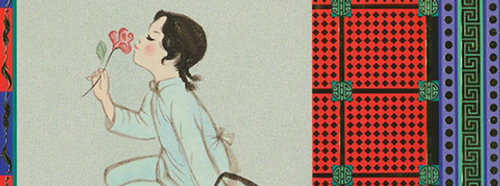
New Zealand and the People's Republic of China celebrated the beauty and splendour of the rose in this joint stamp issue. The two stamps featured the Rosa rugosa and the Aotearoa-New Zealand roses.
Issue information
There has been a continuing argument as to when the rose first evolved. Gerd Krussman in his excellent book The Complete Book of Roses concluded that it was long before the evolution of Man. The number of fossil remains is remarkably small, but we do know that fossilised Rosa hoerneri was found in Tieh-chiang-kon, Kanshu, China 1935,which brings us back 300,000 years. The discovery of Rosa chanwangensis in Shantung, China by Chaney in 1938 places fossil remains which resemble Rosa rugosa going back many more millions of years.
The importance of China in the history of the rose is immense. In the last 150 yeras, botancial expeditions from Europe to Asia have brought back from China alone Rosa banksia, chinensis, filipes, fortuniana, laxa, mouesii, odorata, rugosa, soulieana and xanthina, to name but a few.
The Chinese were the first to use roses as garden plants, probably during the reign of Chin Nun, 2737 B.C. Confucius in 450 B.C. mentions roses being planted in the Imperial Palace of Peking. There are Chinese paintings of Rosa rugosa (Mei kuei) from the 10th century. The word rugosa comes from the latin ruga, which means wrinkled or corrugated. This undoubtedly refers to the rather crinkled look of the heavily veined foliage. While the extra healthy, abundant foliage is one outstanding feature of the rose, probably its huge scarlet hips produced about two months after flowering, would be its dominant characteristic.
The hips are valued for their beauty, but also for their high nutritional value. Field mice are also attracted to them, eating the fleshy seed pod but ignoring the seeds. Many of the species were once-flowering, but rugosa flowers continuously, if not profusely, all summer long, and the high colouring of the autumn foliage is most attractive. Consequently, it was a very important rose for breeding and was used extensively at the turn of the century for hybridising new varieties. Coming from the north of China, it likes cool conditions. It is also a rose that prefers sandy, light soil. For that reason it is widely planted in coastal areas, where it resists the vagaries of salty sea air or dry conditions.
There are now many forms and hybrids, but the typical rugosa grows to about 1m, and the stems are covered in dense prickles. These prickles which make the plant difficult to handle have given rise to the nickname 'Hedgehog Rose'. The single flowers of dull pink or white have a distinctive fragrance. The plant spreads rapidly by means of suckers and the dense growth makes it an ideal hedge or barrier for motorways. As it is known as one of the hardiest of all roses, it has been widely grown in colder areas in the world.
In parts of Europe, rugosa has had another use - it has been used as the understock for standard or tree roses. One stem from a small cutting is trained up to a height of 2m by attaching it to a cane. These stems are them sold by the tens of thousands to nurseries, where they are planted and budded with Hybrid Teas and Floribunda. Even longer stems are used for weeping standards and shorter stems make beautiful tub plants for patios. Rose breeders have realised that the two most important characters a rose must have are health and fragance and rugosa has both in abundance.
The Aotearoa-New Zealand rose was bred by Dr Sam McGredy as his gift to New Zealand to celebrate the 150th anniversary in 1990. The rose was named at the request of the then Prime Minister David Lange. Sam McGredy started breeding the roses that would eventually lead to the Aotearoa-New Zealand back in the 1960s. Starting with Anytime, this rose was combined with Moana to create the soft pink Seaspray. This was then crossed with the Hydrid Tea rose Dreaming to produce the sensational Sexy Rexy which is known around the world for its immense freedom of flowering.
He then crossed Sexy Rexy with an unnamed seedling and then crossed this with the huge red Hybrid Tea called Ferry Porsche, named for the car manufacturer, and this produced the Auckland Metro. To try and increase the perfume he crossed this with Harmonie, and this produced the Aotearoa-New Zealand, a most beautiful soft pink, hugely fragant and majestic bloom.
The stamps were available as se-tenant pairs of two 40 cent stamps, as well as in a miniature sheet. Both the New Zealand and Chinese stamps carried the same design and all four stamps appeared on the first day cover.
Product listing for Roses
| Image | Title | Description | Price |
|---|---|---|---|
| Se-tenant Set | Mint, used or cancelled se-tenant set of two x 40c New Zealand stamps. | $0.80 | |
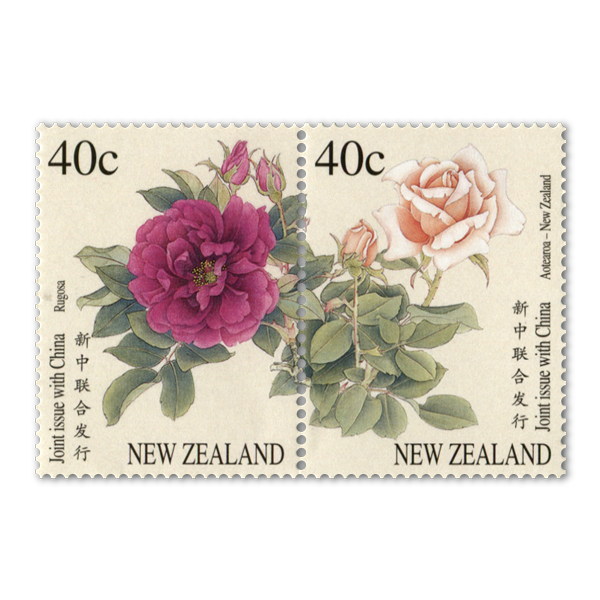 |
Se-tenant Set | Mint, used or cancelled se-tenant set of two x 40c Chinese stamps. | $0.80 |
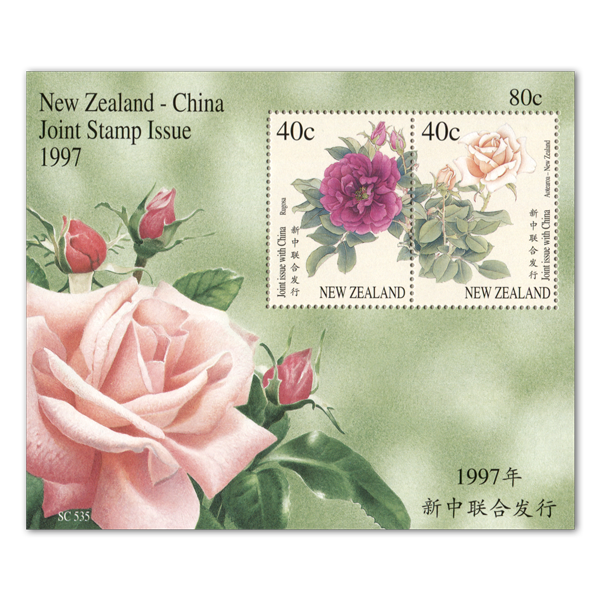 |
Miniature Sheet | Mint, used or cancelled miniature sheet. | $0.80 |
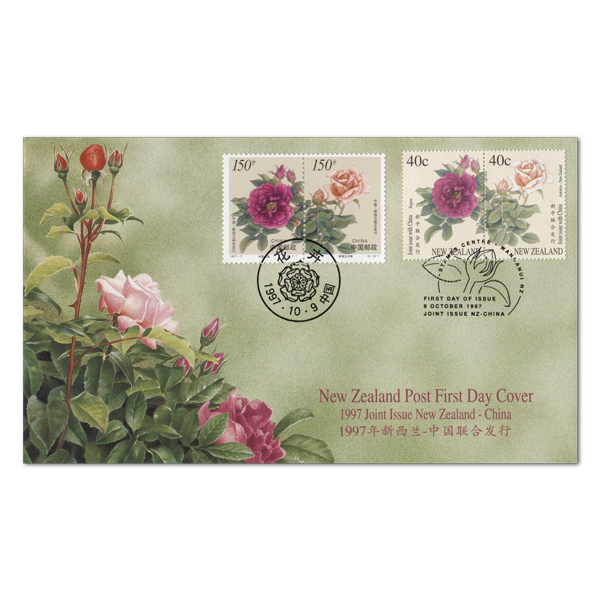 |
First Day Cover | First day cover with two New Zealand and two Chinese stamps affixed. Cancelled on the first day of issue. | $2.10 |
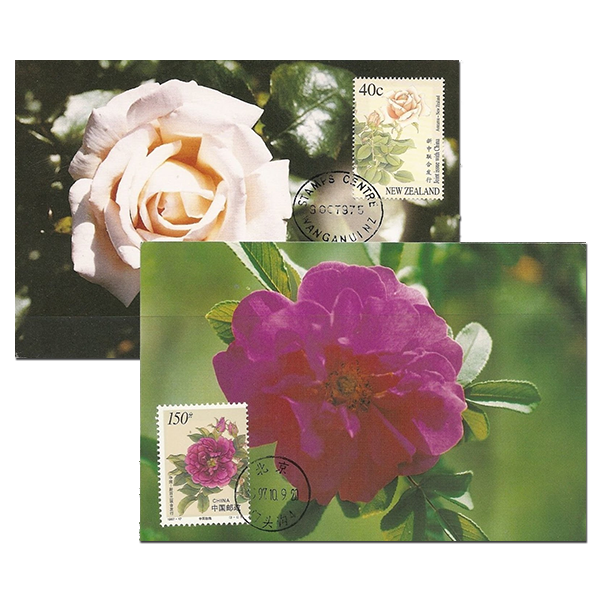 |
Set of Maximum cards | Set of two postcards featuring enlargements from the stamp issue. | $3.60 |
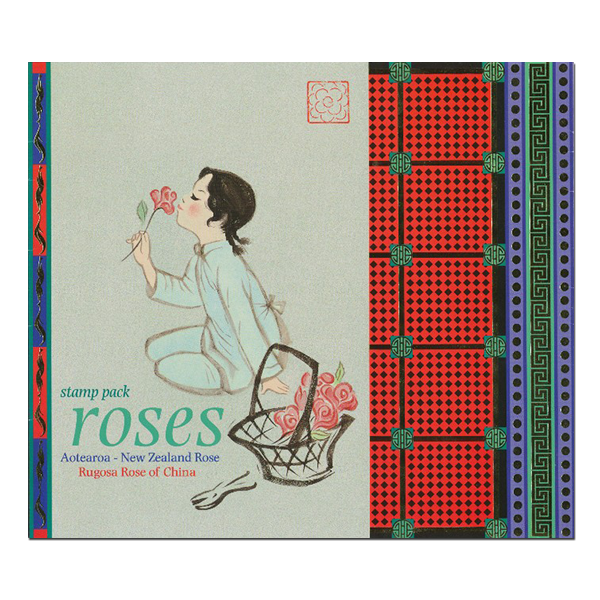 |
Presentation Pack | Presentation pack containing a selection of stamp products from the issue and further information on the theme of the stamps. | $7.95 |
Technical information
| Date of issue: | 12 November 1997 |
|---|---|
| Number of stamps: | New Zealand: two; China: two |
| Denominations and designs: | New Zealand: 40c Rugosa and 40c Aotearoa-New Zealand in se-tenant format; China: 150 Yuan Aotearoa-New Zealand and 150 Yuan Rugosa in se-tenant format |
| Stamps illustrated by: | Zhang Guizheng, Beijing, People's Republic of China |
| New Zealand miniature sheet and first day cover designed by: | Paul Martinson, Masterton, New Zealand |
| Printers and process: | New Zealand (stamps and miniature sheet): Southern Colour Print, New Zealand by lithography; China: The Stamp Printing Bureau of the Ministry of Post and Telecommunications, People's Republic of China |
| Stamp size and format: | 30mm x 40mm (vertical) |
| New Zealand miniature sheet size and format: | 115mm x 95mm (horizontal) with two New Zealand stamps |
| Paper type: | Red phosphor coated, unwatermarked |
| Number of stamps per sheet: | New Zealand: 100; China: 40 |
| Perforation gauge: | New Zealand: 14; China: 11.5 |
| Cost of unadressed first day cover with two New Zealand and two Chinese stamps: | $2.10 |
| Special blocks: | Plate/imprint, positional or value blocks could be obtained by purchasing at least eight New Zealand stamps. |
| Colour blocks: | Also known as 'traffic lights', these blocks were included in plate blocks of New Zealand stamps. |
| Barcode blocks: | barcode blocks for New Zealand were available in both A and B format. |
| Period of sale | These stamps remained on sale until 9 October 1998. |
